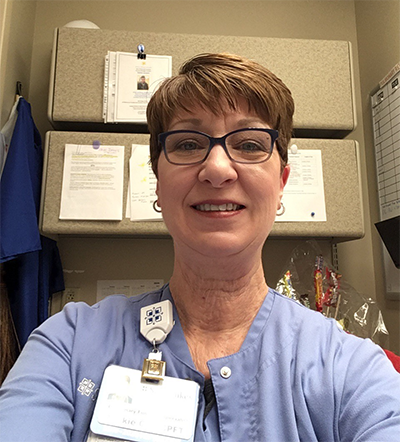

When Vickie Klein’s mother-in-law died of lung cancer at the relatively young age of 48, she wondered why there were so few resources available to help her and her family understand why.
“I looked into respiratory therapy and I had the opportunity to shadow a respiratory therapist,” she recalled. “This launched a new beginning and a decision to help those who are struggling to breathe.”
For Klein, a CRT, CPFT, at Saint Luke’s East Hospital in Lee’s Summit, MO, the best way to help those struggling to breathe has been to work in pulmonary rehabilitation.
Setting and attaining goals
Each day is a new day, says Klein.
“Once we receive a referral, we contact the patient and start the process,” she said. “This is where we really get to know the patient, from daily performances to nutritional needs, patient psychological measures, and oxygen needs.”
Patients are drawn fully into the rehabilitation process, working closely with respiratory staff to set goals that are meaningful to them. Klein and her colleagues teach individualized problem-solving skills to help them reach self-efficacy and attain the goals they set out for themselves.
“We monitor their exercise sessions and promote teachable moments,” she said. “Pulmonary rehab helps get the patient to be more active with less shortness of breath and to feel less stress and have a more positive outlook about their health and future.”
Klein encounters plenty of challenges along the way, but for her the worst of them lies in the fact that so many patients never even get the chance to take part in a program like hers.
“The number one question that we hear from patients is, ‘When I was diagnosed with COPD, why didn’t I get in sooner?’” she said. “We need to get to a point where if your patient is diagnosed with lung disease, you should automatically think pulmonary rehab.”
The fact that reimbursement for PR comes up short is a sticking point for her too.
“With COPD being the third leading cause of death, why is pulmonary rehab reimbursement lower than average?” she asked.
Extended family
But the rewards that flow from working with patients who so desperately need help regaining their quality of life more than offsets any downsides to the specialty for Klein.
“My passion is teaching patients that they can go to the store, climb stairs, or do something that we take for granted, like taking a shower,” she said. Her patients become like extended family to her in the process. “We laugh and we cry at times,” she says.
Klein recommends the area to any RT who would enjoy that level of camaraderie with their patients.
“In pulmonary rehab you take a journey with your patients and you see the measured success and the attitude,” she said. “The therapist within the hospital observes an improvement, but we see the future!”
What do you need to do the job? Good assessment skills and lots of patience, says Klein.
“The patient’s lung disease didn’t happen overnight, so developing reasonable, attainable goals is extremely important,” she said.
It’s something she enjoys doing every day.
“I have loved working in rehab these last 28 years,” Klein said.
Want to learn more about pulmonary rehabilitation? Join the Ambulatory and Post-Acute Care Specialty Section. Many AARC members who work in the PR setting can be found there.





